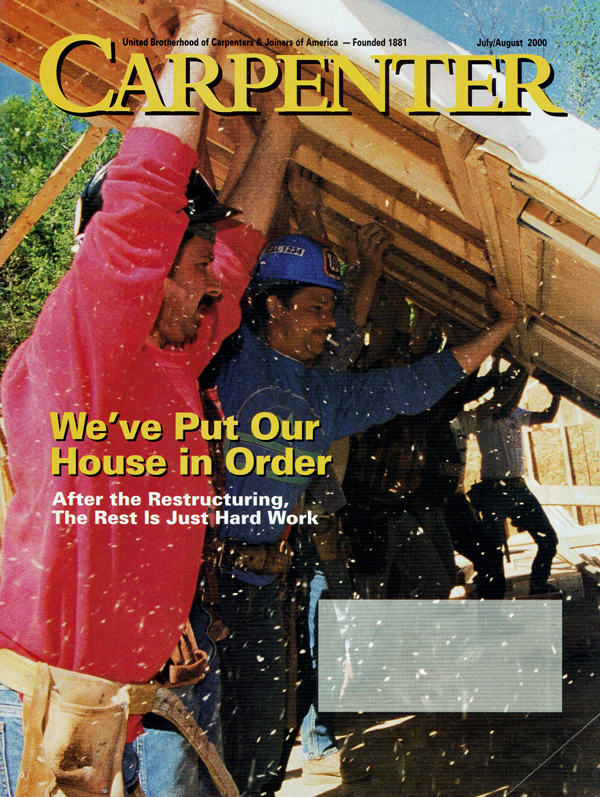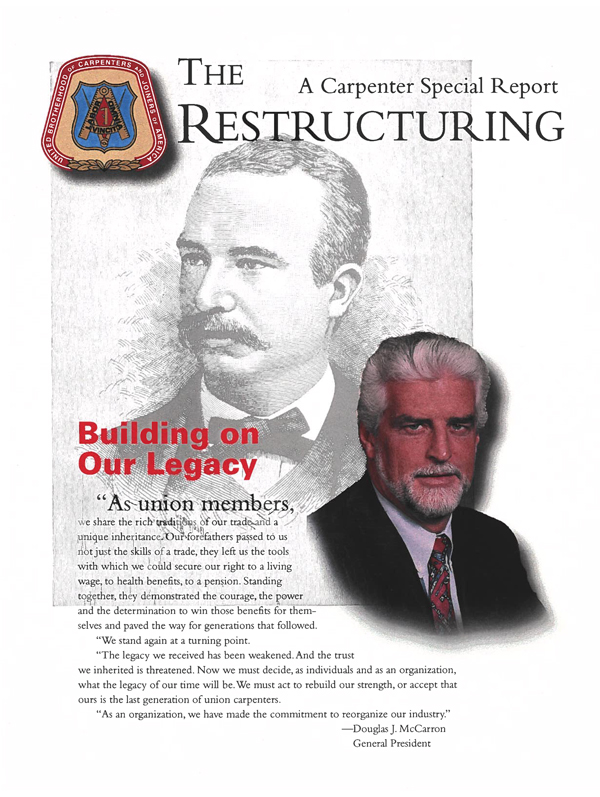In 1995, A Pivot Point
The founding members of our union left a legacy of excellence, as skilled carpenters and as carpenter-to-carpenter organizers dedicated to creating a union that would stand the test of time.
Industry-best training, good wages, a safe workplace, health benefits and pensions have long been the building blocks to protect UBC members and families in the face of constant technological change and competition. Through economic depression and boom times, we helped develop our cities and towns, build schools and highways and create the middle class in the United States and Canada.
It has never been easy as, for 140 years, opposition from anti-union politicians and big business has challenged the UBC and workers in both countries. In Canada, labour relations occur at the provincial level and UBC members get involved in political action to elect candidates who will appoint favorable members of provincial labour relations boards—or to fight anti-union board policies. Canadian members also contend with the Christian Labour Association of Canada (CLAC), an employer-friendly “union” that drives down standards and underbids union contractors.
In the U.S., an anti-union tide surged in the 1980s. It was the culmination of the fallout from the passage of right-to-work and other anti-union measures over decades, the election of anti-union politicians at the state and national level, and the rise of the Business Roundtable and the Associated Builders and Contractors (ABC).
Those groups helped an aggressive non-union sector to begin swallowing up market share that our union had taken for granted. Many construction markets were affected, including those that had been well-organized in the past. Meanwhile, since the 1950s the UBC had focused heavily on the “service” side of its representational duties, while organizing, growing and welcoming new members took a back seat.
Making things worse, the UBC’s structure was a huge barrier against growth and innovation. As the industry became more regionally and nationally oriented, the UBC kept its town-by-town structure, including rigid local union boundary restrictions that kept many members from mobility and work opportunities. These restrictions may have made sense in an earlier era but needed rethinking in a new climate.
At the tumultuous 36th General Convention in 1991, delegates fiercely debated the course of the union. A special constitutional convention in 1993 continued the discussion.
The turning point came in 1995, when delegates to the 37th General Convention elected President Douglas J. McCarron and his team of general executive board members on a platform of broad change and renewal.
The team dedicated itself to organizing and putting the needs of all working carpenters first—and resolved to embrace bold changes that could set the union on a path of growth. The stakes were high, as McCarron wrote in a special report to the membership in 1998:
“The legacy we received has been weakened. And the trust we inherited is threatened. Now we must decide, as individuals and as an organization, what the legacy of our time will be. We must act to rebuild our strength or accept that ours is the last generation of union carpenters.”
Some loudly criticized the leadership’s platform. Clearly, implementation of the proposed changes to the UBC’s orientation and structure were painful. As President McCarron noted, “For a union with a proud history and strong traditions, the changes are difficult, but essential.”
Twenty-six years later, the UBC’s decision to rebuild the Brotherhood has kept the union fiscally sound and firmly on a path of growth—even during recession and the current pandemic.
Here are key elements of our union today:
Regional councils became the member-powered centers of the UBC’s new structure, and the general executive board established that local and council leaders would be “held accountable for achieving UBC goals, strategies and vision,” according to a 1996 letter to local leaders from President McCarron.
Today, the leaders of our 24 regional and district councils meet regularly to help chart the union’s course and plan implementation of UBC programs.
The 1995 leadership team rededicated the union to organizing and established the goal of reaching 70 percent market share in each of our craft areas and in all geographic areas. To get there and win more work opportunities and higher standards for members, regional councils began unleashing creative area standards campaigns.
These combine a mix of top-down and bottom-up tactics, coalition building, street actions and political activism—including our industry-leading campaign to stand up for workers who are exploited through misclassification, wage theft and other forms of tax fraud in construction.
“Fighting for all carpenters is the right thing to do,” said Second General Vice President Dave Tharp. “And it helps UBC members and contractors compete on a level playing field for work opportunities.”
In the late 1990s, the UBC executive board evaluated the union’s 40-year-old headquarters building at 101 Constitution Ave. in Washington, D.C., and made a bold decision to demolish the structure and build a new headquarters in its place. From an outdated structure that was bleeding financially we now have a modern headquarters that remains one of the premier addresses for leased office space in the nation’s capital.
More importantly, our headquarters generates millions in annual income that has helped to strengthen the union’s programs and our bottom line.
“The UBC officers at the time thought with and made the bold investment in the future,” said Tom Flynn, General Secretary-Treasurer. “It continues to pay dividends today, not just financially but in the presence the UBC has in the nation’s capital.”
The 1995 leadership team embraced “comprehensive organizing,” which included educating and training members—to help members build careers and to strengthen the union for the future. Again, the blueprint was bold and forward-thinking, with no half-measures. See Page 4 for our anniversary report on the International Training Center and the union’s skills training and leadership development programs, which are recognized as industry game-changers and have helped to transform the union.
“Organizing continues to be the core of the UBC mission,” said Frank Spencer, General Vice President. “Thanks to the structure and programs we have in place we are better situated than ever to grow our markets and ensure our industry partners can compete.”
Since 1995, UBC members have been called upon continuously to build the union and dedicate themselves to excellence. That is no different from the call our first members answered from founders Peter J. McGuire, Gabriel Edmonston and Frank Duffy: to Organize, Organize, Organize!
By stepping up to the challenge every day, we will keep our union strong for future generations.

